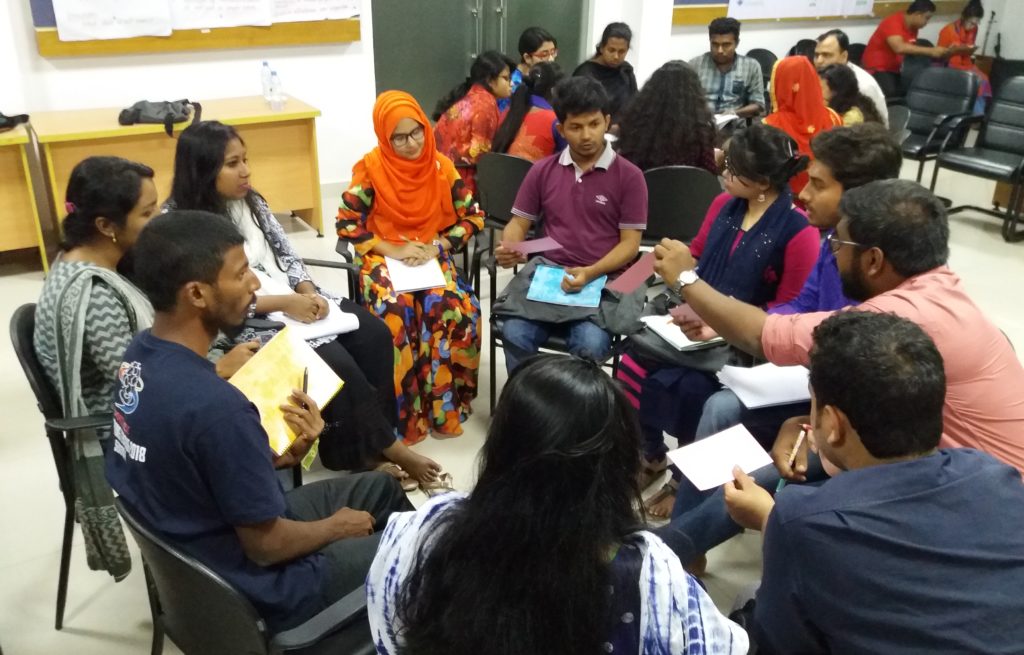This article is based upon the presentation by Dr. Haseeb Md. Irfanullah at the Research to Reader (R2R) Conference 2019 on 25 & 26 February 2019. Dr. Irfanullah is a biologist-turned-development-practitioner with a keen interest in research and its communication. He is a member of the editorial board, and has twice been an executive editor, of Bangladesh Journal of Plant Taxonomy. Haseeb is available at hmirfanullah@yahoo.co.uk and he tweets as @hmirfanullah
Over the last couple of decades, Bangladesh, a country aiming for moving out of the UN’s List of Least Developed Countries by 2024, has seen three remarkable transformations in scholarly publishing.
How has Bangladesh’s scholarly communication changed in recent decades?
First, thanks to a number of global initiatives, like INASP’s Programme for Enhancement of Research Information (PERI) (between 2001 and 2013) and Research4Life (since 2002), focusing on developing countries, Bangladeshi researchers have been getting access to global scientific publications by major publishers at affordable prices.
Revolution in the information and communications technology sector has not only made this happen; it has also significantly boosted Bangladeshi researchers’ global reach – and this is the second major transformation. Widely available and accessible online communication with the global academic publishing ecosystem and websites for many Bangladeshi journals have made it possible. In particular, in 2007, INASP’s launch of the Bangladesh Journals Online (BanglaJOL) journal platform created a tremendous opportunity for Bangladeshi journals to showcase themselves on a single online platform. As of now, 142 journals, almost all science journals, published by Bangladeshi publishers are hosted on BanglaJOL. There are many other Bangladeshi journals not hosted here, but BanglaJOL does cover a significant portion. Many journals, like my journal Bangladesh Journal of Plant Taxonomy, have benefited enormously from the exposure enabled by BanglaJOL.

The third major change over the last decade or so has been the investments in developing the understanding and capacity of the Bangladeshi researchers and journal editors in international academic publishing standards and practices. Over the last 12 years or so, INASP and its AuthorAID project together with Bangladesh Academy of Sciences (BAS) and other agencies have regularly been organizing training sessions, workshops, and discussions on research and journal publishing. INASP has also provided grants to Bangladeshi organizations to organize similar events and some organizations got inspired and organized their own events. Over the last couple of years, NGOs such as Oxfam in Bangladesh (the photo for this post was taken at an Oxfam Bangladesh workshop for young researchers in March 2018) have also been collaborating with Bangladeshi universities to undertake research projects and publishing the research outputs.
As far as capacity development is concerned, the Gobeshona Young Researcher Workshop is an interesting example. It was organized by ICCCAD between 2015 and 2017, supported by the USAID Bangladesh. A total of 60 young climate change researchers participated in three cycles of four workshops, where they were trained and mentored on how to publish their research in indexed, peer-reviewed journals. By 2018, about one-third of them had managed to publish their work.
Nevertheless, these initiatives are often carried out in isolation from each other and sometimes limited to particular groups. There was a need for collective effort to improve the academic publishing ecosystem of Bangladesh with a common understanding of the concerned stakeholders. Keeping that in mind, in December 2016, the First BanglaJOL Dialogue was organized in Dhaka by BAS and INASP. I designed and facilitated this event participated in by 30 journal editors. This event led to the formulation of a Roadmap to improve the journal publishing practices in Bangladesh. The implementation of the roadmap, however, was not followed up due to an absence of leadership and ownership from the institutions concerned.
Where does Bangladesh’s journal publishing stand today?
To answer this question, we can measure the state of Bangladeshi journals in two ways. The first measure comes from looking at BanglaJOL journals in the Journal Publishing Practices and Standards (JPPS) database. JPPS is a venture of African Journals Online and INASP launched in late 2017. It evaluates journals hosted in different Journals Online (JOL) platforms against a series of criteria and assigns them to one of six categories: New title, Inactive, No stars, One star, Two stars, and Three stars.
As of February 2019, out of a total of 419 journals hosted on five JOLs (Bangladesh, Central America, Mongolia, Nepal, and Sri Lanka), 46 (11%) received Two stars in their JPPS assessment. None have received Three stars yet. However, on BanglaJOL, alarmingly, 47% journals were ranked as Inactive, since they did not upload any new content in over more than a year. Only seven journals received Two stars, which is only 5% of the total 142 journals hosted by this platform, much lower than the global proportion.
The second measure came from a survey I conducted with 29 BanglaJOL journals in November 2018. It was found that 90% of the journals were available both in print and in electronic formats; only four journals were published online only. Around 75% of the journals on average took one to five months to process submitted manuscripts (from submission to final decision), which is quite commendable. More than a quarter of the journals had foreign researchers on their editorial boards, half of all journals used international reviewers, and almost 70% of the journals published papers by foreign authors − all indicating internationalization of the surveyed journals.
However, only about 60% of the responding journals had been published in print on time and only 40% of the journals were confident that they also published online on time. And a similar proportion were continuing to struggle to get their journal out online on time. These figures match the challenges about timeliness observed in the JPPS assessment that has led so many Bangladesh journals to be categorized as inactive. About 60% of the journals were indexed by at least one international indexing agency (excluding BanglaJOL). One journal mentioned being indexed by as many as 13 systems.
So, while many Bangladeshi journals are doing well in certain vital publishing standards and practices, most are struggling.
Two of the most striking findings from the survey were around finance. More than 70% of the journals did not charge any money from their authors. Those who charged, usually charged manuscript handling fees or color plate or extra page costs. The average cost to publish a journal issue was US$1,100, with a range of US$240−4,760. This low expense matches the fact that almost all Bangladeshi journals are run on a voluntary basis (editors and staff) and the office cost is almost absent. My survey, for example, showed that although around two-thirds of the journals had designated offices and/or designated staff, half of the staff were unpaid by the publisher learned societies or volunteers.
Why Bangladesh shows isolation in scholarly publishing
Despite being part of the global scholarly ecosystem, Bangladesh’s journal publishing has developed ways to thrive in relative isolation. The reasons for such isolation also depend on how the country’s scholarly society and the society in general perceive researchers, research, and its communication.
Bangladesh’s apparent isolation in scholarly publishing exists for two reasons. First, journal publishing in Bangladesh is self-sustaining, both financially and content-wise. The cost of journal publishing is very low and is paid by the concerned learned societies or institutions and/or by the government. Moreover, locally generated manuscripts are sufficient to publish on average two issues per year and journals are not dependent on or do not need international authorship. Second, the current publishing system works for the researchers as the content providers; they can use it to get promotion and recognition. So, in general, there is no real need, motivation or incentive for improving Bangladeshi journal’s quality, standards or practice by individual journals.
In terms of perceptions of the society towards research, the benefits of home-grown research are rarely highlighted by the media or by the politicians. Being an agrarian country, agricultural research is an exception. The genome decoding of jute, for example, took the media by storm, but this was because it was related to the heritage, identity, and economy of the country. Researchers are often perceived as thinkers, not really change-makers. We also see limited scope of hardcore research in the development decision-making process. The career of a researcher is often not very clear.
In mid-February 2019, I explored the current academic staff recruitment and promotion rules of seven public universities of Bangladesh. In almost all cases, journal papers do not have any advantage, if these are published in non-Bangladeshi or indexed journals or journals with Impact Factors. Unified guidelines for recruitment and promotion of all public universities’ teachers of Bangladesh were proposed by the government in December 2017, where all recognized journals are expected to be peer-reviewed, and in certain cases indexed in Scopus and/or having an Impact Factor. But these guidelines have not been fully implemented yet.
As of February 2019, only three Bangladeshi journals have a Journal Citation Reports’ (JCR) Impact Factor, eight are included in Pubmed, and 17 are ranked by the Scimago Journal & Country Rank (SJR). It shows that the international mechanisms for ensuring journal quality have limited influence over such self-imposed scholarly isolation.
How to break scholarly isolation
Since the isolation has been created by the country, I propose two streams of activities to be led by the country to change the situation positively.
First, regular dialogues should be organized among the researchers, the journal editors, the policy-makers (e.g., concerned ministries and University Grants Commission of Bangladesh), bodies coordinating research institutions (e.g. Bangladesh Agricultural Research Council, BARC), and other stakeholders. A similar event was organized by INASP and BAS in November 2018 on improving equitable research system in Bangladesh, as well as several African countries, and was well received.
Such events offer multiple benefits. They can clear up misunderstandings and myths around journal publishing; fill in knowledge gaps, and provide updates on what is going on in the scholarly world globally, e.g., Plan S and the use of Artificial Intelligence in scholarly communication. As a secondary benefit, it also gives a country a sense of position − where its research and research communication stand in the world.
Through dialogues, trust is built among the actors, which helps to create a shared vision to improve the publishing system. Dialogue can also help concerned people to realize how ‘scholarly isolation’ would hurt the country, and what they will be missing by continuing in this manner. Bangladesh’s research on Bangladesh may remain unrecognized by the global community, while work on Bangladesh done by foreigner researchers would get due recognition. This situation was seen by analyzing the IPCC’s Fifth Assessment Report of 2014, which referred largely to climate change work on Bangladesh led by foreign scientists rather than Bangladeshi researchers.
But, dialogue alone is not enough; it needs to be accompanied by some specific policies, institutions, and support systems – as the second stream of actions. A national system is crucial to oversee and guide country’s journals’ quality and standards, backed by strong political and policy support.
Gaining political backing for research communication is a challenge in the Global South. In Bangladesh, however, the government is very committed to achieving the Sustainable Development Goals (SDGs). Linking scholarly communication with monitoring the progress towards the 169 targets of the 17 SDGs may get due political support.
This political support could be translated into a ‘National Journal Publishing Rule’ by the Ministry of Science and Technology, in association with the Ministry of Education, Directorates of Archives and Library, and the BARC, which coordinates 10 national agricultural research institutes. This would, in turn, be reflected in the recruitment and promotion rules of the universities and public research organizations.
The proposed ‘National Journal Publishing Rule’ would not only guide how journals should be published in Bangladesh, but also would establish a ‘Bangladesh Journal Watch’ to monitor the quality of Bangladeshi journals in the light of the evolving global scholarly publishing system.
Given the current state of Bangladesh’s journals, a support system is also crucial to improve the reputation of Bangladesh’s research and research communication. To help the journals and their editors, an ‘Editing Helpdesk’ needs to be established under the auspices of a competent organization.
While in recent years, we have seen repeated discussions on how the North-South divide in research and scholarly publishing ecosystem can be reduced, Bangladesh tells us a story of a nation’s journal publishing thriving in isolation, thus becoming a case of “Global reading, local publishing”. Through country-led actions, Bangladesh can show how to come out of this isolation and become truly global.
Discussion
7 Thoughts on "Guest Post — What Does Bangladesh Tell Us About Research Communication?"
An interesting insight into academic publishing in the Sub-Continent.
Academic publishing and issues- good one.
Excellent compilation and great article. Would request to publish a summary in Bangladesh and in newspaper.
Hi Nurullah — we leave all rights to our posts with the authors, so please contact Dr. Irfanullah directly for permission to translate/reprint.
Dear Nurullah,
Thank you for your comment.
If you are interested to publish a summary of my article in Bangla, let us communicate via email. My email address is hmirfanullah@yahoo.co.uk
Thanks,
Haseeb
Links to the slides presented at R2R and a video of the presentation can be found here: https://r2rconf.com/2019/03/29/irfanullah-has-scholarly-kitchen-article/
Thank you so much Mark Carden, for sharing the link to the video and the slides.


